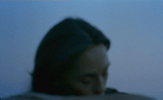While I’m not at all enraptured by the murky, elliptically fractured, and characteristically amoral transgressive cinema of Philippe Grandrieux, I also cannot help but be drawn to certain aspects of his filmmaking that I find undeniably sublime in the sensorial purity of their realization. One such moment occurs in an early episode in Grandrieux’s debut feature film, Sombre: an eerily silent shot of Jean (Marc Barbé) looking away from the camera at a vacant lot (a recurring image of the back of his head that prefigures the psychological ambiguity and enigmatic motivation of Olivier in Jean Pierre and Luc Dardenne’s The Son) juxtaposed against the crashing waves of a turbulent stream. The seemingly unstable, unfocused image drifts into and out of frame, intermittently revealing the outline of a female form lying violated and lifeless near his feet. Grandrieux’s introduction to Jean is also ingeniously conceived – a disorienting tracking shot of a lone automobile on a dark, tortuous road set against the foreboding, ambient, mechanical drone of an engine that cuts to the sound of children screaming as they watch a puppet play at a guignol, where Jean, uncoincidentally, performs as a puppeteer. This introductory image of primal reaction, instinctive terror, manipulative control, and possession compactly (and evocatively) sets the tone for the film’s thematically (and visually) dark tale of impossible love as the restless Jean carves a violent path of sexual encounters – and serial murder victims – until a virginal, stranded motorist named Claire (Elina Löwensohn) momentarily offers him a glimpse of the possibility of intimacy and complete love.
As convenient as it would be to be completely dismissive of Grandrieux’s provocational cinema, there are certainly traces of visually abstract, but innately cohesive – and emotionally lucid – elements within his style that are difficult to find fault with, particularly in the implementation of complex, raw, and highly textural visual strategies that complement Jean’s primal, aberrant psychology. Moreover, there is a discernible process of authorship at work in Sombre that betrays an overarching deliberativeness towards the film’s construction, from echoes of Jon Jost’s Last Chants for a Slow Dance (and Alfred Hitchcock’s Vertigo) that can be seen in Jean’s aimless driving through desolate roads (often to cruise for prostitutes who will unwittingly become his future victims), to Grandrieux’s exposition on the blurred delineation between passion and violence – and the psychological rapture that both acts achieve for the antihero – that would be similarly echoed in Claire Denis’ subsequent experimental horror film, Trouble Every Day. It is this underlying intelligence that ultimately makes Grandrieux’s film a worthwhile, though irresponsible and morally bankrupt experience.
© Acquarello 2005. All rights reserved.
